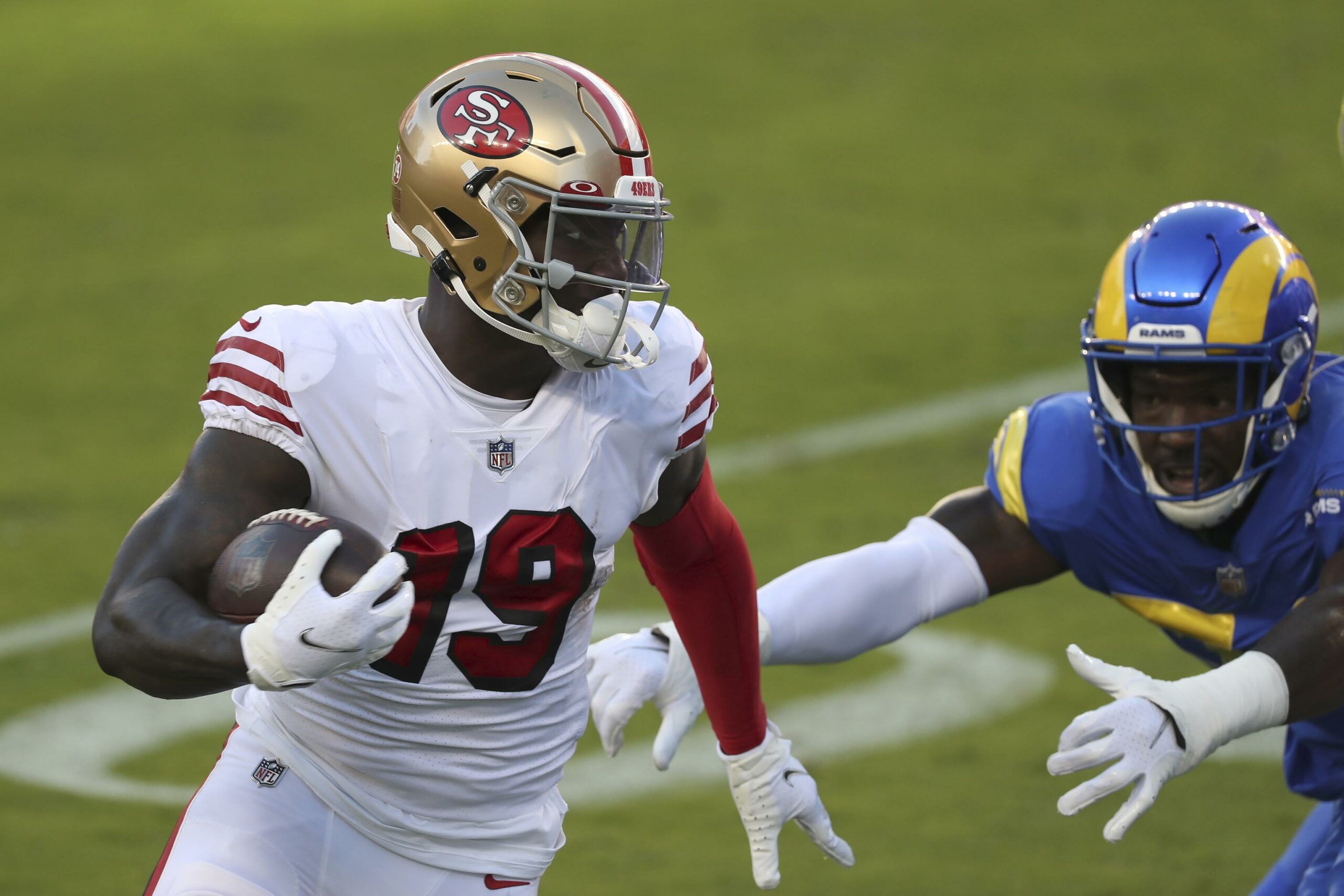
One of the best ways to identify buy-low wide receivers is Air Yards.
The reason why this metric can be so predictive is that it gives us a picture of what the coach (by calling the play) and quarterback (by throwing the pass) want.
A curl for 7 Air Yards tells a much different story of this intention from the coach and quarterback than a go route for 30 Air Yards. While Air Yards give us a picture of what the coach and quarterback want, they also demonstrate the skill of the receiver, because it means the receiver is earning targets that have a higher likelihood to end up as big plays.
Air Yards also end up being one of the most sticky stats for receivers year-over-year. We like Air Yards.
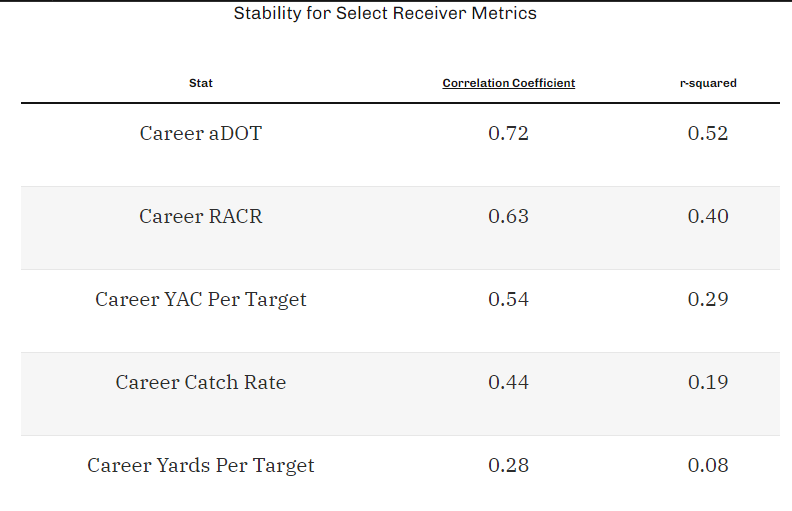
And so if a player ends up with a bunch of Air Yards, but doesn’t have the fantasy production to match, we can make a guess that the next season, things will balance out and the production will rise to match the opportunity. This is exactly why we are so excited about Terry McLaurin’s prospects moving forward.
I say all of this, because out of all of the stats in the NFL this season, Deebo Samuel’s 70 Air Yards (No. 113) have me the most confused.
Granted, Samuel has only played in five games, but D.K. Metcalf can get 70 Air Yards in a half, much less an entire five games stretch. To further demonstrate the point: Metcalf has only had fewer than 70 Air Yards once in a game this year (51 against Patrick Peterson and the Cardinals).
So, what do we make of Samuel and his touch passes, screen passes, and drag routes? More importantly for our purposes, is he a player than we need to be selling since he seems totally reliant on YAC, a far less sticky stat than Air Yards (just ask for JuJu Smith-Schuster)?
This calls for a Deebo deep dive!
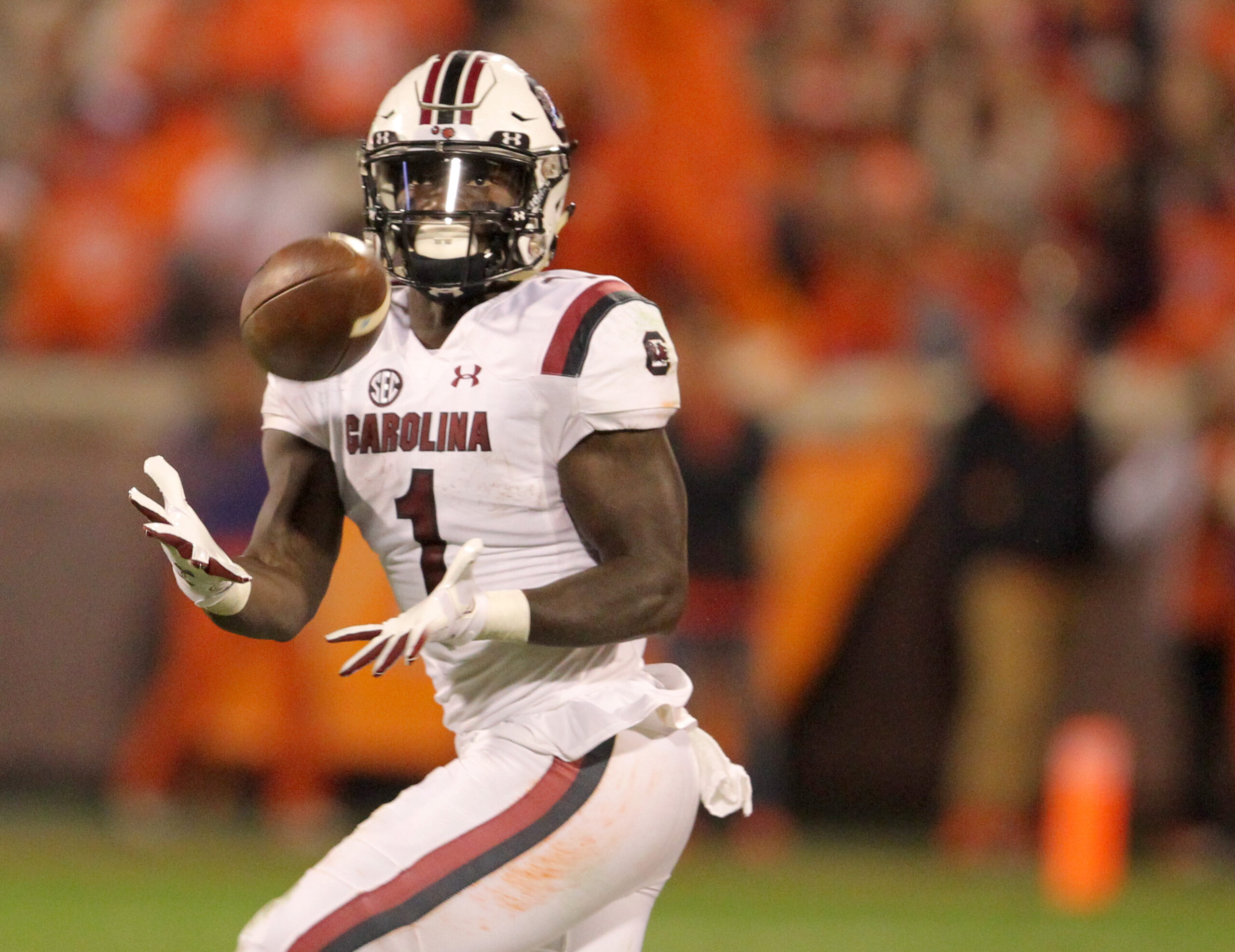
Collegiate Profile
There was a lot to like.
Coming out of South Carolina, Samuel looked the part of a Golden Tate-esque, YAC monster. In his career, he was an electric returner, racking up 4 touchdowns on only 42 returns for a 29.0 yard average. He also demonstrated the ability to make plays with his legs by scoring 7 rushing touchdowns on 25 carries.
All of this resulted in an excellent 27.7 Dynamic Score via THE BREAKOUT FINDER.
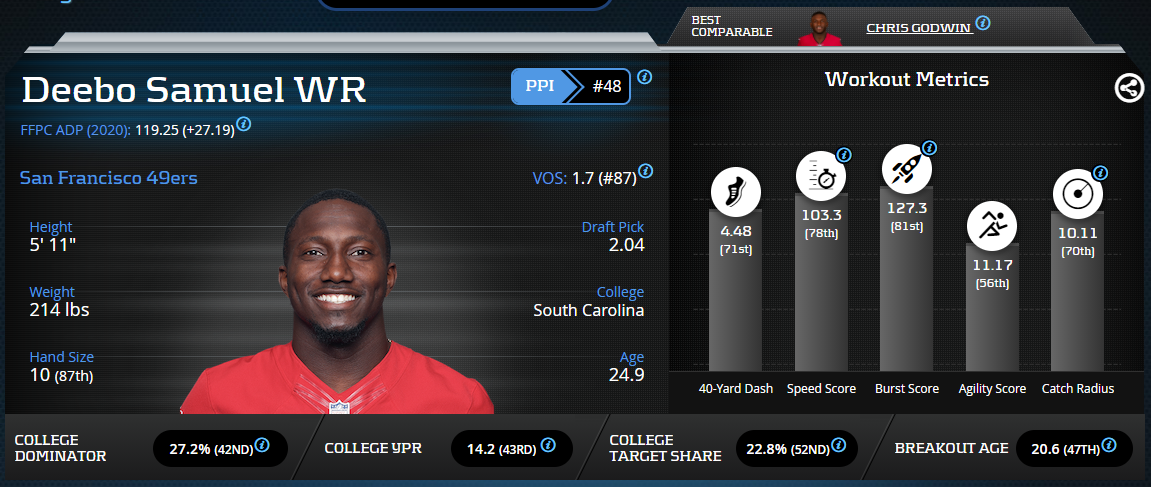
This dynamism showed itself in his athletic testing, too. Samuel impressed with a 127.3 Burst Score (81st) and a 4.48 40-Yard Dash (71st). While athletic testing isn’t everything for receivers, Burst Score can help us predict which players may thrive after the catch.
He was also a good receiver, putting up good numbers against tough SEC competition, while sharing the field with Bryan Edwards. Admittedly, his numbers don’t jump off the page, but a College Dominator of 27.2-percent (42nd) and College Target Share of 22.8-percent (52nd) with a precocious performer like Edwards on the roster is acceptable.
The biggest area of concern on his profile had to be his age.
In general, we like receivers who breakout early and declare before their senior year. Samuel not only stayed for his senior year (understandable, considering he broke his right fibula in Week 3 of his junior season), but his 20.6 Breakout Age (47th) is below average.
All of this paints a picture of a solid possession receiver with good YAC potential, and THE BREAKOUT FINDER gave him a Breakout Rating of 32.8, good for 3rd in the class, after only D.K. Metcalf and A.J. Brown. That means something.
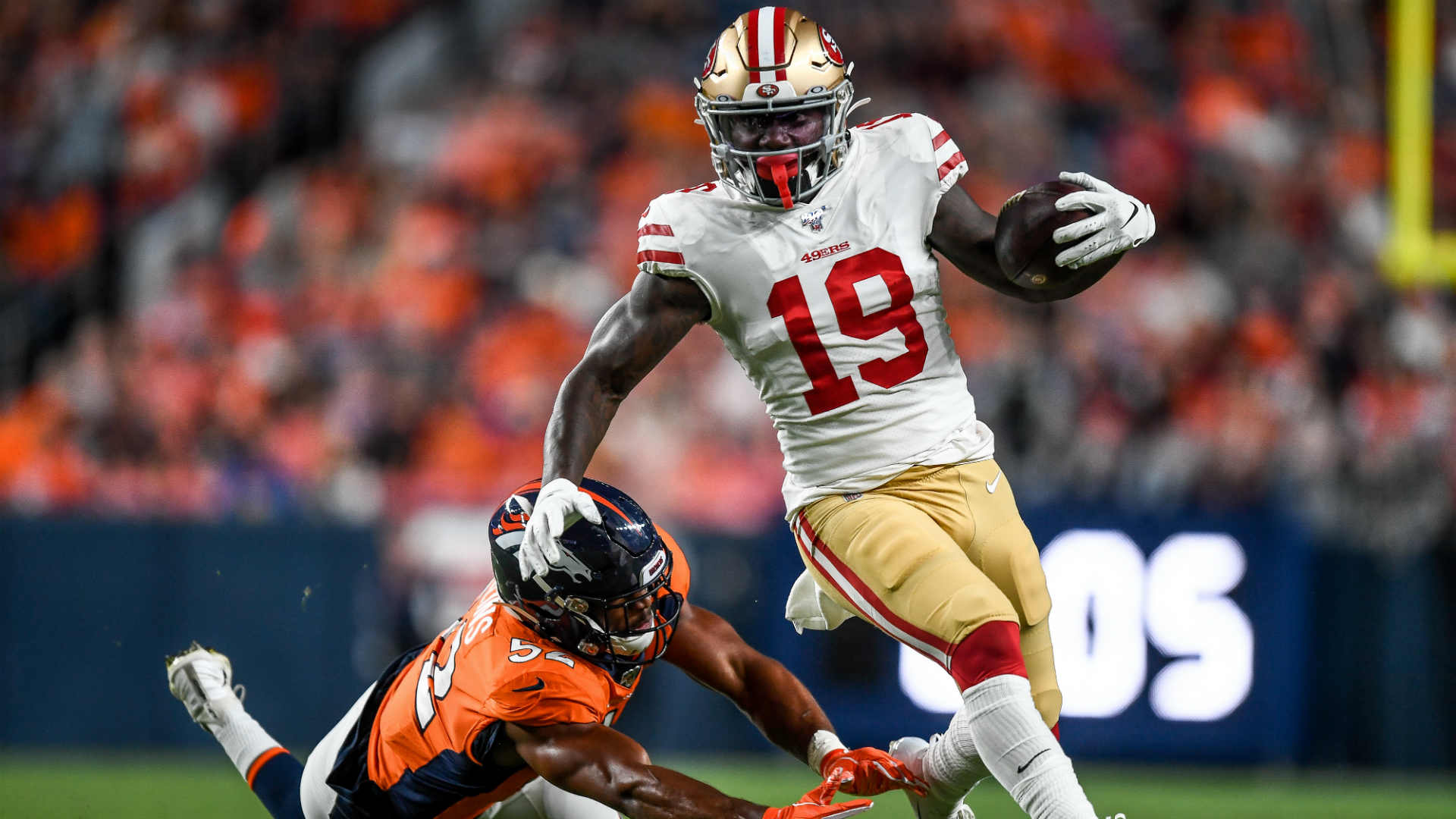
Rookie Campaign, 2019
Getting going early.
When Samuel landed in San Francisco alongside Jalen Hurd, he entered into a murky situation. The 49ers had selected Dante Pettis in the second-round and Richie James in the seventh-round the year before. Additionally, George Kittle was a year removed from his sophomore season spectacular and Emmanuel Sanders was there occupying a starting role. With all of this, there was legitimate concern that Samuel could standout as a rookie.
Samuel, as we now know, had different plans.
It only took until Week 2 to breakout with a 5-87-1 line against the Bengals. From Weeks 10 through 17, Samuel was excellent, registering single-digit fantasy points only once and leading to an astounding 2.31 Fantasy Points Per Target (No. 5). His blend of receiving and rushing ability lead to 6 total touchdowns, trailing only Tevin Coleman and Raheem Mostert on the team.
Not too bad for a rookie on a run first offense.
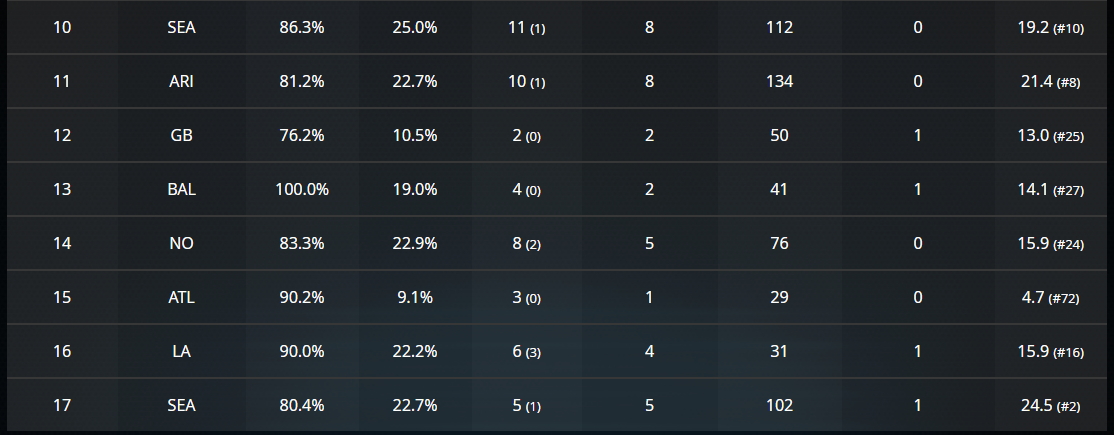
Samuel essentially carried over his college production to the pros and did it in a similar style. He still wasn’t a deep threat with his 7.9 Average Target Distance (No. 92) and 14.1 Yards Per Reception (No. 30), which was almost identical to his College number of 14.2 (43rd). Rather, he made a living tearing up defenses after the catch thanks to his dynamism.
He tallied 461 YAC (No. 5) and was No. 2, behind only [A.J.] Brown, among receivers in YAC+, which estimates YAC gained compared to what is expected for an average receiver given down and distance as well as aDOT. And yet, this low depth of target and high YAC mold seems to be the Sean McVay/Kyle Shanahan way (see Cooper Kupp, Robert Woods, etc.). Samuel may just be the perfect receiver for Shanny, in that case.
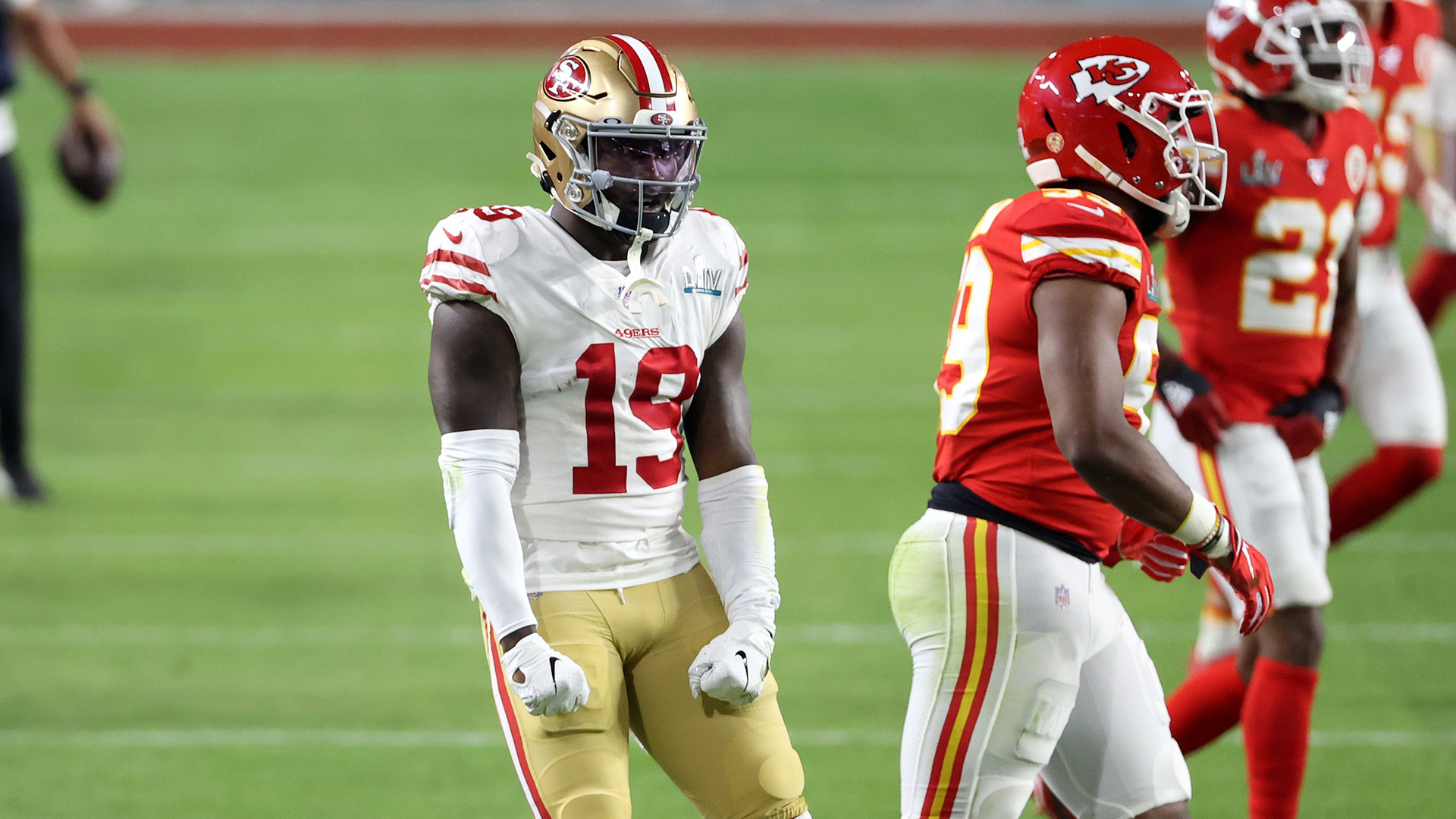
Year Two, 2020
The year of the outlier?
That brings us to this year, and Samuel’s confounding 70 Air Yards.
Again, due to injury, Samuel has only played in five games. This leads to an extremely small sample size, and perhaps we will see some balance. However, Samuel’s Average Depth of Target has plummeted to 2.0 (No. 113), and he comically has -29 Completed Air Yards (yes, that’s a negative). It’s truly amazing how many of his touches start from well behind the line of scrimmage.
This has naturally lead to an insane amount of YAC. He already has 347 YAC (No. 8) in only five games. To put that in perspective, entering the season, YAC-King Tate had put up 1003 YAC over the past five seasons. All of this YAC has impressively lead to 2.48 Yards Per Routes Run (No. 8).
https://platform.twitter.com/widgets.jsMost YAC by a WR last 5 seasons:
— PFF (@PFF) July 19, 2020
1. Golden Tate – 1003
2. Larry Fitzgerald – 674
3. Jarvis Landry – 631 pic.twitter.com/tAxUpG0FKb
Where we should be concerned is that many of his efficiency metrics are lacking. His Production Premium is only -6.5 (No. 58) and the QB Rating when Targeted is a measly 89.9 (No. 71). Also of concern is Brandon Aiyuk, who was taken in the first-round this year. They haven’t played much together, but Week 7 has us worried that Aiyuk, and not Samuel, will be the target-hog after Kittle in this offense.
https://platform.twitter.com/widgets.jsdeebo samuel and brandon aiyuk were similar prospects coming into the nfl and their box scores looked similar.
— the podfather (@Fantasy_Mansion) October 26, 2020
*aiyuk: 7 tgts, 6 rec, 115 yards
*samuel: 6 tgts, 5 rec, 65 yards
…until you look at the air yards.
*aiyuk: 105
*samuel: -10 pic.twitter.com/AKb1Ka03Wb
Closing Thoughts
The “what should I do” part.
We know Samuel is good after the catch, but not a threat downfield, commanding Air Yards.
Are Air Yards everything? Of course not, but the lack of Air Yards puts a significant cap on Samuel’s potential, as does the presence of Aiuk.
The hope is that Samuel is a YAC-King in the mold of Tate. The next Tate, if you will. We might forget that Tate was awesome in Detroit, racking up yards like a bowling ball in the secondary. Tate posted a gaudy 99-1331-4 line in 2014 with Calvin Johnson playing 13 games.
To do that, Samuel will need to command targets at a greater clip than his 21.0-percent Target Share (No. 34), and continue cutting through defenses after the catch, which he seems more than able to do.
I have him everywhere, and will hold him in most places, knowing that his ceiling isn’t as high as I hoped, but also realizing that he should be a reliable, yet unspectacular, option in the future. However, if you can use Samuel (plus picks and/or prospects) to get up to a true alpha receiver like McLaurin, do it.


